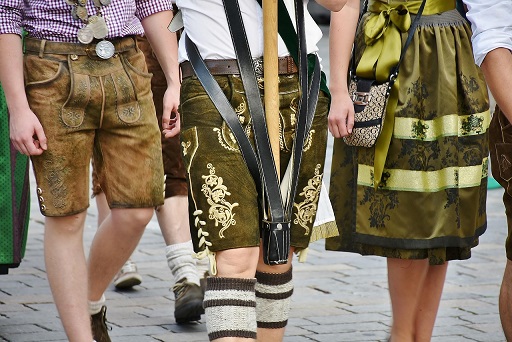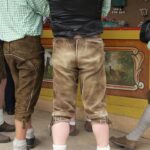
To many outsiders, traditional German clothing conjures images of frilly Dirndls, rugged Lederhosen, and steins of beer raised at Oktoberfest. But in Germany, the world of Tracht – traditional dress – is experiencing a quiet but powerful renaissance. From fashion runways to hip urban weddings, modern Germans are reinterpreting heritage attire in bold, stylish, and surprising ways.
This article explores how Tracht is evolving: who’s wearing it, what’s changing, and what this revival says about German identity today. Whether you’re a fashion enthusiast or a cultural traveler, you’ll find inspiration in how the old is being made new again.
What Is Tracht, Really?
Tracht refers to regional traditional garments historically worn for work, religious holidays, festivals, or daily life. It can include:
- Dirndls and aprons (for women)
- Lederhosen or Bundhosen (for men)
- Embroidered bodices, vests, waistcoats
- Hats, shoes, jewelry, and shawls
Each region of Germany – from Bavaria to the Black Forest to Saxony – has its own distinct styles and customs. Historically, Tracht was a marker of place, faith, marital status, and social class.
But Tracht also reflects change: its use and meanings have always adapted to the times. That adaptability is now fueling its 21st-century comeback.
The Return of Tracht: Why Now?
Several forces have contributed to the renewed popularity of traditional German clothing:
- Cultural heritage revival – A desire to reconnect with roots, especially among young people.
- Tourism and festivals – Oktoberfest culture has globalized Tracht, making it fashionable (and profitable).
- Slow fashion movement – Handmade, durable garments are appealing in an era of sustainability.
- Pop culture and media – German musicians, influencers, and designers are showcasing modern Tracht.
Rather than representing outdated conservatism, modern Tracht is being embraced as a blend of tradition and personal expression.
Dirndl 2.0: Sleek, Feminine, and Fashion-Forward
The Dirndl, once a humble working woman’s outfit, is now a canvas for creativity. Contemporary Dirndls vary in length, cut, and fabric, with nods to haute couture and even streetwear:
- Knee-length cuts with minimal aprons for a youthful look
- Dark colors and velvet trims for eveningwear
- Bold prints or denim fabrics for urban edge
- Lace bodices and sheer sleeves for wedding or gala Dirndls
Designers like Lena Hoschek, CocoVero, and Julia Trentini have taken the Dirndl far beyond Bavarian clichés, showing it off at fashion weeks, weddings, and upscale events.
Many younger women wear Dirndls as a statement of feminine strength and cultural pride. Even the apron bow, which traditionally signals relationship status (left = single, right = taken), is being worn more freely.
➡️ Related: Dirndl Decoded: The Meaning Behind Germany’s Most Iconic Dress
Lederhosen Reinvented: Slimmer, Lighter, and Urban
Modern Lederhosen retain the rustic charm of the originals but with updates to fit contemporary tastes:
- Slim-fit silhouettes rather than baggy traditional cuts
- Soft suede or eco-leather for comfort and sustainability
- Bright stitching or bold embroidery to reflect personality
Men’s Tracht now includes a wider range of accessories too: from high-end watches and designer shoes to bespoke shirts. Young men wear Lederhosen at Oktoberfest but also at weddings, birthdays, and even business functions – especially in southern Germany.
➡️ Explore more: Lederhosen Lore: From Peasant Gear to German Pride
Tracht for Everyone: Inclusive, Non-Binary, and Global
Modern Tracht is also becoming more inclusive. Designers are:
- Creating gender-neutral styles that blend masculine and feminine cuts
- Encouraging BIPOC Germans to explore heritage wear
- Celebrating LGBTQ+ visibility within Tracht culture
Some fashion collectives and youth groups reimagine Tracht as a tool of cultural hybridity, blending German elements with Turkish, African, or Slavic styles. This is particularly evident at cultural festivals in Berlin and Hamburg, where Tracht is worn with pride and fluidity.
High Fashion Meets Heritage
Major German fashion designers have embraced Tracht’s aesthetic. Collections often include:
- Modernized bodices inspired by Dirndls
- Pleated wool skirts with folkloric motifs
- Structured vests and jackets with heritage cuts
Tracht has appeared at Berlin Fashion Week, in editorial spreads, and in capsule collections for luxury brands. This fusion of rural heritage and urban fashion reflects Germany’s growing appreciation of its visual identity.
Sustainability and Local Craftsmanship
Another reason for Tracht’s popularity? It aligns perfectly with slow fashion values:
- Locally made with regional materials
- Durable and often handmade
- Timeless designs that avoid trends
Tracht garments are often passed down through families or custom-made by local tailors. Many brands emphasize natural materials like wool, linen, cotton, and deer leather sourced sustainably.
Buyers are increasingly willing to invest in quality Tracht that lasts for years – as both fashion and heirloom.
Where and When Is Modern Tracht Worn?
Traditional clothing has moved far beyond its niche. Today’s modern Tracht is worn at:
- Weddings – especially in southern Germany
- Oktoberfest and similar festivals nationwide
- Company events and galas
- Church holidays and family reunions
- Fashion events or photoshoots
For many, wearing Tracht isn’t just tradition – it’s pride. It connects the wearer to community, craft, and story.
➡️ Go deeper: Beyond Bavaria: Regional Costumes You’ve Never Heard Of
Modern Makers: Who’s Leading the Revival?
Some key figures and brands shaping modern Tracht include:
- Lodenfrey (Munich) – Blending luxury with heritage
- Angermaier – Known for bold contemporary designs
- Lena Hoschek (Austria) – Feminine vintage-style Dirndls
- CocoVero – Young, playful reinterpretations of Dirndls
- Wiesn Glupperl – Accessories that poke fun at tradition
Many artisans are also reviving traditional techniques – embroidery, hand-dyeing, leather carving – to keep the craftsmanship alive.
Challenges: Between Celebration and Commercialization
As Tracht becomes more fashionable, debates arise:
- Is Tracht being commodified?
- Do mass-produced costumes dilute cultural meaning?
- Can Tracht still reflect authentic identity?
Critics argue that cheap imitations sold at festivals risk turning Tracht into parody. Advocates counter that popularity brings visibility, and that respectful wear can foster deeper appreciation.
Tradition With a Tailored Twist
Modern Tracht is not just about nostalgia. It’s about identity through evolution. Young Germans are proving that tradition can be relevant, exciting, and deeply personal.
Whether you wear a Dirndl to a wedding, a fitted Lederhosen to a birthday, or a fusion Tracht to a fashion show, the message is the same: this is who I am – and this is where I’m from.
➡️ Continue exploring the series:







